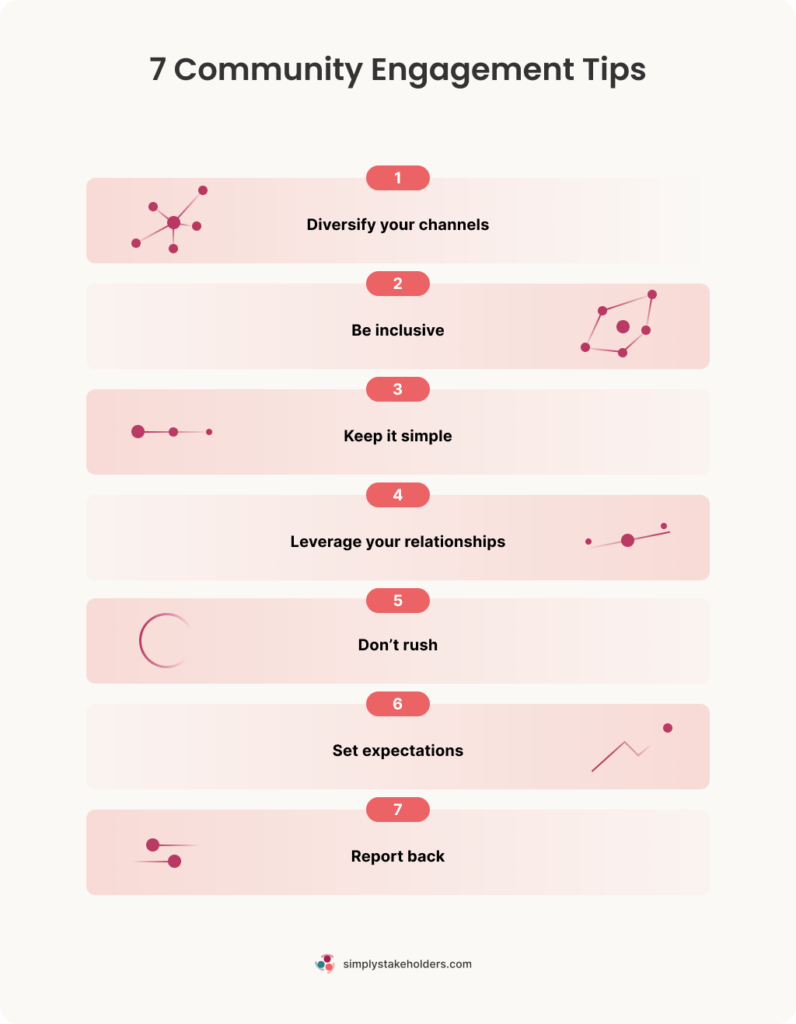Engaging Communities: 7 Tips to Boost Participation

Need to engage a local community in your project? Community engagement has an important role to play in many projects — not only to meet regulatory requirements, but to increase support and awareness, and gain valuable insights that help to shape project planning and outcomes.
But engaging communities doesn’t always look like other forms of stakeholder engagement. Along with the benefits we’ve already touched on, it comes with its own set of unique challenges.
So, we’ve put together a list of 7 tips to help you increase participation and engage your local community. But first… a quick definition.
What is Community Engagement?

Community engagement is a stakeholder engagement approach that focuses on engaging communities. Most of the time, communities are the people who live within the area impacted by a project or organization, but a community could also be defined as a group of people with common interests.
Engaging communities may involve sharing information, building relationships, managing interactions, and gathering feedback in relation to the organization or project.
For a more detailed definition, head to our blog on Community Engagement: Definitions, Benefits & Examples.
Why Engaging Communities is Key for Projects
Organizations tend to conduct community engagement in order to achieve specific project outcomes, such as:
- Gaining local knowledge – Tapping into what community members know about a region, its culture, its needs, and its opportunities can be invaluable for project planning, sustainable outcomes, and a successful project
- Reducing risk – Engaging with the community (especially early on) can identify potential roadblocks, objections, and delays so that the organization can manage or mitigate them
- Increasing support – Getting members of the public to participate in a planning process, it can create a sense of shared ownership which is linked with higher levels of support
- Increasing acceptance – For projects that would otherwise face a lot of opposition, community engagement can help to build awareness of the project’s benefits, understanding of what (if any) can realistically be changed, and social acceptance
- Meeting obligations – In some regions and industries, engaging with impacted communities is an ethical and legal obligation to ensure that people can voice their concerns and (ideally) influence the project
Examples of Successfully Engaging Communities

So, what does it look like when you successfully engage a community? Here are three examples of what community engagement can look like in practice…
Engaging Communities in Sustainability Initiatives
Sustainability initiatives often rely on individual community members or households changing their behavior and participating in the initiative — and therefore, community engagement is key.
For example, two municipalities in Alberta, Canada found that communication processes and input from community and external stakeholders had a significant impact on sustainability planning. Citizens were able to develop a common language for sustainability through education, with this dialogue facilitating the planning process and community change. This led to communities seeing themselves as part of a larger sustainability network.
Engaging Communities in Research Projects
Academics and researchers often need some level of stakeholder understanding and cooperation in order to conduct their research. Engaging communities in a research project is often an important first step — after all, community members need to be aware of the project, and be convinced that it’s worth their time and attention. And to do that, researchers must first get to know a community’s interests and needs, which allows them to position the benefits of their research, and even adapt their research to the greater benefit of the community.
As a side note, part of the research process can also resemble the community engagement process — analyzing, identifying groups, building relationships, planning, interviewing, surveying, running focus groups, and reporting back with your findings.
Engaging Communities in Policy Development
Governments and regulators typically engage a number of different stakeholders in policy development, including members of the community. However, engaging these communities can be challenging — especially due to the varied understanding, interests, backgrounds, and abilities within a given community. It can be particularly challenging to engage disadvantaged communities in policy, so policymakers need to pay special attention to ensuring these groups have adequate opportunities to get involved.
For example, if a city needed to review its policy for street parking, it would (ideally) get plenty of community input before making any changes. This policy would impact residents, businesses, road users, and visitors to the area. As part of policy consultation, the city would need to ensure they get input from a group that genuinely represents the communities via a variety of community engagement activities (both online and offline). This could include workshops in various locations, letters, emails, phone calls, door knocking, focus groups, surveys, and more. After mapping out key issues from the community and workshopping various solutions the city could confidently recommend a solution that considers all perspectives and impacts.
7 Tips for Engaging Your Communities

Ready to improve your community engagement? You’ll find no end of tips online, but we’ve found that most organizations can most benefit from working on the following areas.
1. Diversify Your Channels
If you only offer one or two ways for community members to participate in your engagement, you’ll greatly limit the types of community members who may get onboard. By providing multiple channels (social media, face-to-face, email, events, written submissions, collaborative sessions, surveys, online platforms, focus groups, etc.) you’ll capture a broader group of people with different needs, preferences, abilities, and demographics — who are more likely to accurately represent the community as a whole.
2. Be Inclusive
Building on the importance of diverse channels, it’s important to consider other ways you can promote inclusion with your community engagement initiatives. Some groups might be harder to reach due to location, education, disability, transport access, venue access, socio-economic disadvantage, and other factors. Consider how you might be able to reduce barriers to participation and actively encourage participation from these groups. And monitor the types of people who are engaging with different forms of engagement so you can determine whether your efforts have been successful, or whether you need to take a different approach.
3. Keep it Simple
Your communication with community stakeholders should be clear and straightforward. After all, your community will include people from a variety of backgrounds and you should aim to be understood by as many people as possible. Avoid ambiguous terms and technical jargon, and always check to make sure your meaning is clear.
4. Leverage Your Relationships
Consider taking a more strategic approach by leveraging any existing stakeholder relationships you have within the community. Create a stakeholder relationship network to understand how you and your stakeholders are already connected — then see which relationships you may need to build and strengthen in order to better promote your community engagement opportunities.
5. Don’t Rush
Engaging communities takes time. So, give yourself plenty of time to start the engagement process early on in the project — this is also important to ensure any feedback and input from the community can actually have an impact on planning before any critical decisions are set in stone. And give your stakeholders advance notice (and regular reminders) about any events, consultation opportunities, and relevant deadlines.
6. Set Expectations
Let your community members know ahead of time what they can influence — and what’s already decided. Manage people’s expectations around what information you’ll share, where you’ll share it, and how often they’ll hear from you. By setting the community’s expectations, they’ll be able to focus their efforts where it matters.
7. Report Back
Don’t leave your community hanging or wondering how their participation impacted any decisions or project outcomes. Always report on how you engaged your community, what the responses were, and how those responses were used. And even before that, make sure you respond to any comments/questions and thank anyone who took the time to participate.
By the way, it’s much easier to track your community and report back with stakeholder engagement software like Simply Stakeholders. Learn more about what to look for when investing in community engagement software or reach out to our team if you’d like a demo.
Learn More
Interested in learning more about community engagement? Check out our previous posts:
- 7 Signs You’re Getting Your Community Engagement Right (Or Wrong)
- Best Community Engagement Strategies in 2023
- Strategies for Successful Community Engagement in Government
- How to Encourage Community Group Engagement
- 5 Critical Features For Your Community Engagement Tool
- How Can I Increase Online Community Engagement?






























